Plush toys are beloved companions for children and adults alike, bringing comfort, joy, and nostalgia. But what happens when these cherished toys get dirty, yet cannot be washed in the traditional way? Washing some plush toys can cause damage like deformation, color fading, or stuffing clumping, posing a real dilemma for owners wanting to keep them clean and fresh.
Cleaning plush toys that cannot be washed requires careful, non-invasive methods such as gentle dusting, vacuuming, spot cleaning, and odor removal using natural agents. These approaches preserve the toy’s integrity while maintaining hygiene and freshness.
Imagine a child hugging their favorite plush toy that’s been with them for years — stained, dusty, but too delicate to put in the washing machine. How do you clean it without risking damage? This article dives deep into effective, safe ways to refresh and maintain plush toys that are off-limits for machine or hand washing, helping you keep these treasured companions in great shape.
1.What Are the Risks of Washing Plush Toys That Cannot Be Washed?
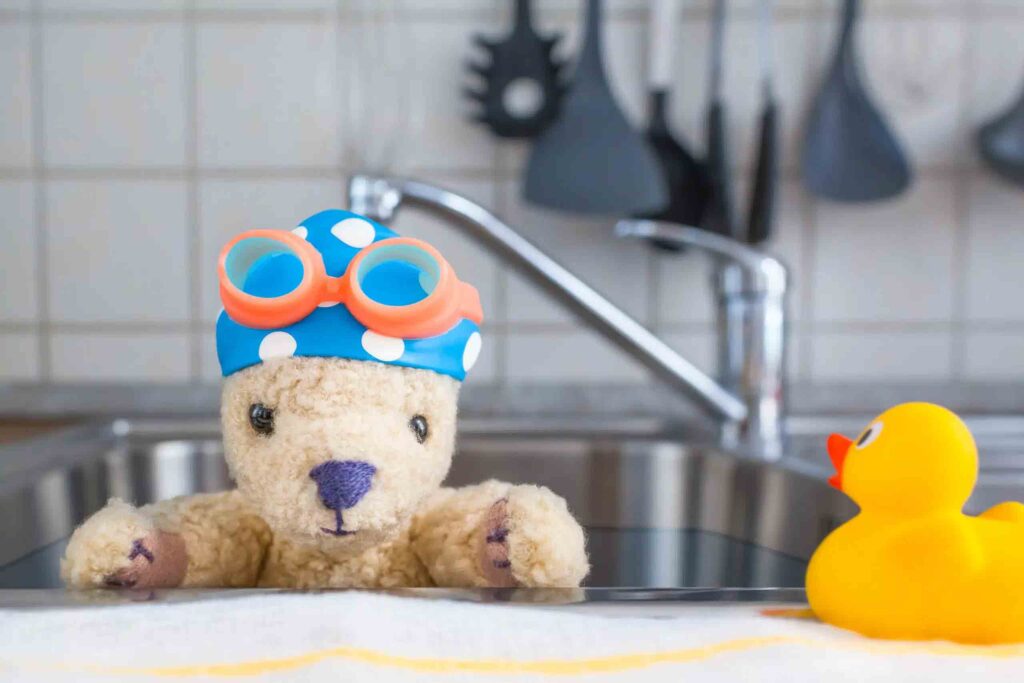
Washing plush toys that aren’t designed for water cleaning can cause irreversible damage, including fabric shrinkage, loss of softness, color bleeding, and internal stuffing clumping or deterioration.
Non-washable plush toys risk structural damage, deformation, and color fading if washed improperly, making alternative cleaning methods necessary.
- Material Sensitivity: Some plush fabrics like velvet, silk blends, or vintage materials can be water-sensitive and lose texture or color when wet.
- Stuffing Damage: Toys stuffed with delicate materials (e.g., cotton, foam pellets) may clump, harden, or degrade after washing.
- Structural Components: Plush toys with glued-on parts, electronic components, or delicate embroidery can be ruined by moisture.
- Colorfastness Issues: Bright or dark dyes might bleed or fade when exposed to water or detergents.
- Long-Term Durability: Frequent washing of delicate toys accelerates wear, reducing lifespan and aesthetic appeal.
These risks highlight why it’s critical to identify whether your plush toy can tolerate washing before attempting any cleaning process.
| Risk Category | Beschreibung | Example / Detail |
|---|---|---|
| Material Sensitivity | Water-sensitive fabrics may lose texture or color when wet | Velvet, silk blends, vintage materials |
| Stuffing Damage | Delicate stuffing can clump, harden, or degrade after washing | Cotton, foam pellets |
| Structural Components | Moisture can ruin glued parts, electronics, or embroidery | Toys with glued-on eyes, electronic features, delicate stitching |
| Colorfastness Issues | Bright or dark dyes may bleed or fade with water exposure | Vibrant or dark-colored plush toys |
| Long-Term Durability | Frequent washing accelerates wear and reduces toy lifespan and appearance | Repeated washing causing fabric thinning or softness loss |
2.Which Materials and Plush Toys Require Special Cleaning Methods?

Plush toys made from delicate fabrics like mohair, velour, silk, or with sensitive fillings require gentle, water-free cleaning methods to avoid damage.
Materials such as mohair, vintage fabrics, or toys with foam fillings need special care and alternative cleaning solutions.
- Mohair Plush: Often used in collectible or high-end teddy bears, mohair is fragile and loses its softness if wet.
- Velour and Velvet: Water spots can stain and alter texture.
- Foam or Pellet Stuffing: Absorbs water and clumps, making drying difficult.
- Mixed Material Toys: Those with leather patches, ribbons, or glued parts require spot cleaning.
- Electronic Plush: Toys containing batteries or electronics must never be immersed in water.
- Vintage and Heirloom Toys: Older toys are often fragile and best cleaned with dry methods or professional care.
Knowing your toy’s material and construction helps determine the safest cleaning approach, preventing accidental damage.
| Material / Toy Type | Cleaning Considerations | Details / Examples |
|---|---|---|
| Mohair Plush | Fragile fabric; loses softness if wet | Used in collectible or high-end teddy bears |
| Velour and Velvet | Water spots can stain and alter texture | Sensitive to moisture |
| Foam or Pellet Stuffing | Absorbs water; clumps and difficult to dry | Requires water-free cleaning |
| Mixed Material Toys | Requires spot cleaning due to delicate patches or glued parts | Leather patches, ribbons, glued components |
| Electronic Plush | Must never be immersed in water | Toys with batteries or electronic components |
| Vintage and Heirloom | Often fragile; best cleaned with dry methods or professional care | Older, collectible toys |
3.How Can You Safely Remove Dust and Surface Dirt from Non-Washable Plush Toys?
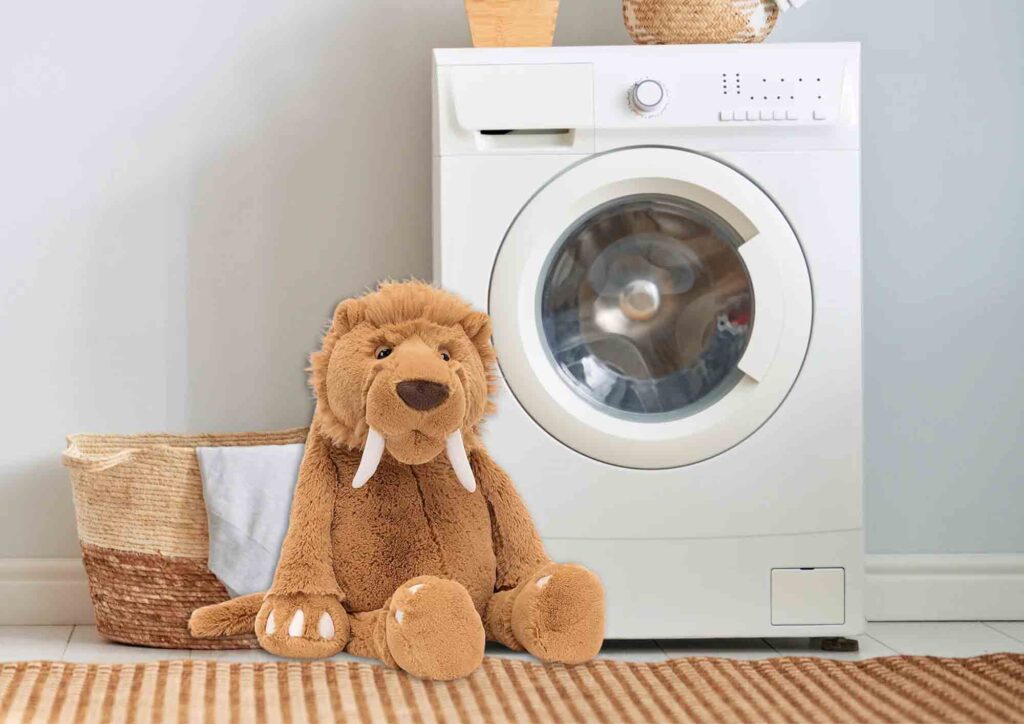
Dust and surface dirt can be gently removed using soft brushes, low-power vacuum cleaners with brush attachments, or gentle wiping with microfiber cloths.
Use gentle brushing, vacuuming, or light wiping to remove surface dirt without exposing toys to water.
- Soft Brushing: Use a baby hairbrush or soft-bristle paintbrush to lift dust without damaging fibers.
- Staubsaugen: A handheld vacuum with a mesh screen can remove embedded dirt safely.
- Dry Sponge or Rubber Eraser: Specialty dry cleaning sponges or gentle erasers remove grime from plush surfaces.
- Microfiber Cloth: Slightly dampened (not wet) cloths can spot-clean delicate areas.
- Compressed Air: Useful for delicate parts, but use cautiously to avoid fiber damage.
- Caution with Stains: Avoid scrubbing hard, which can distort fabric and colors.
By regularly dusting and vacuuming, plush toys stay clean longer and reduce the need for deeper cleaning.
| Reinigungsmethode | Beschreibung | Tips / Notes |
|---|---|---|
| Soft Brushing | Use a baby hairbrush or soft-bristle paintbrush to lift dust | Gentle on fibers, prevents damage |
| Staubsaugen | Handheld vacuum with mesh screen removes embedded dirt | Use low suction to avoid pulling fibers |
| Dry Sponge or Rubber Eraser | Specialty dry cleaning sponges or gentle erasers remove grime | Effective for surface dirt without moisture |
| Microfiber Cloth | Slightly dampened cloth used for spot cleaning | Avoid soaking; safe for delicate areas |
| Compressed Air | Blows dust from delicate parts | Use carefully to prevent fiber damage |
| Caution with Stains | Avoid scrubbing hard to prevent fabric distortion and color loss | Spot clean gently to protect material |
4.What Are Effective Odor Removal Methods for Plush Toys That Can’t Be Washed?
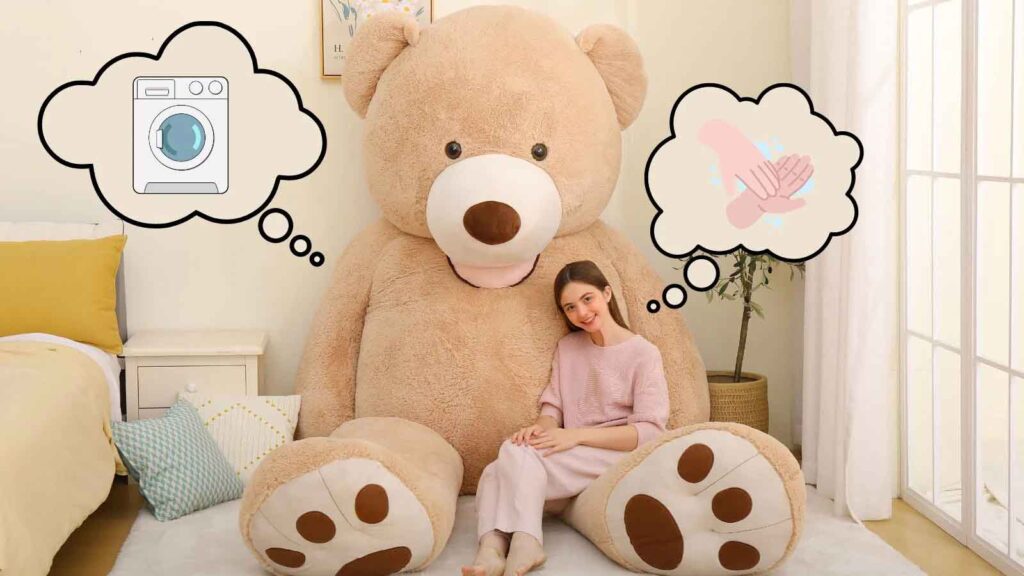
Natural deodorizing agents like baking soda and activated charcoal can safely absorb odors without harming plush toys.
Baking soda and charcoal are effective and gentle odor absorbers for plush toys that can’t be washed.
- Baking Soda: Sprinkle lightly, let sit for 12–24 hours, then brush or vacuum off. Absorbs moisture and neutralizes odors.
- Activated Charcoal: Place near or inside toy in a breathable bag to remove persistent smells.
- Freeze Method: Sealing toys in a plastic bag and freezing kills odor-causing bacteria.
- Essential Oils: Use minimal drops on a cloth nearby for a fresh scent but avoid direct application to avoid fabric damage.
- Avoid Harsh Chemicals: Air fresheners or sprays can harm delicate fabrics and irritate sensitive users.
- Sunlight Exposure: Brief indirect sunlight can naturally deodorize but avoid fading.
These odor removal tactics maintain freshness without moisture or harsh chemicals.
| Odor Removal Method | Beschreibung | Tips / Notes |
|---|---|---|
| Baking Soda | Sprinkle lightly, let sit 12–24 hours, then brush or vacuum off | Absorbs moisture and neutralizes odors gently |
| Activated Charcoal | Place near or inside toy in a breathable bag | Effective for persistent smells without moisture |
| Freeze Method | Seal toy in plastic bag and freeze | Kills odor-causing bacteria safely |
| Essential Oils | Minimal drops on cloth near toy | Avoid direct contact to prevent fabric damage |
| Avoid Harsh Chemicals | Avoid air fresheners or sprays | Can harm fabric and irritate sensitive users |
| Sunlight Exposure | Brief indirect sunlight exposure | Natural deodorizing but avoid prolonged fading |
5.Are There Professional Cleaning Services or Products Designed for Non-Washable Plush Toys?
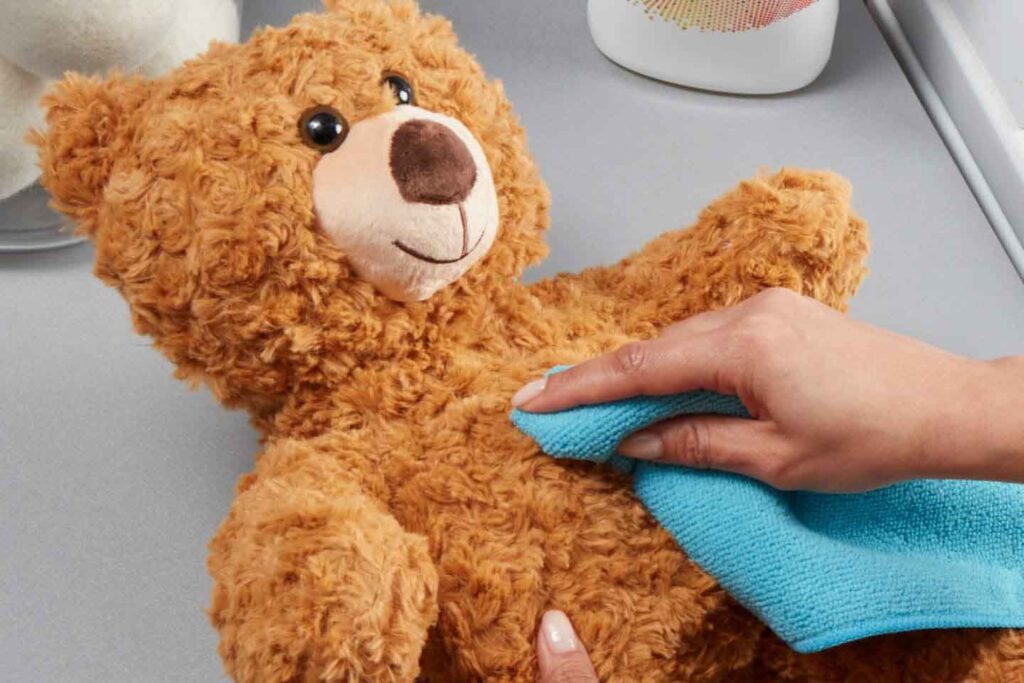
Specialized dry-cleaning powders, steam cleaners, and professional plush toy cleaning services offer safe, effective alternatives for non-washable toys.
Professional services and dry-cleaning products provide expert care for delicate plush toys that cannot be washed.
- Dry-Cleaning Powders: Products like Woolite’s dry cleaner powders absorb dirt and oils without water.
- Steam Cleaning: Low-heat steam penetrates fabric to sanitize and freshen without soaking.
- Professional Services: Toy restoration and cleaning specialists can safely clean heirlooms and collectibles.
- DIY Steamers: Home fabric steamers can refresh plush toys but require caution to avoid heat damage.
- Electrostatic Cloths: Capture dust and hair from delicate plush surfaces.
- Costs vs. Benefits: Professional cleaning may be worth it for valuable or sentimental items but evaluate pricing.
These options balance thorough cleaning with plush toy safety, ideal for hard-to-clean or valuable items.
| Cleaning Option | Beschreibung | Tips / Notes |
|---|---|---|
| Dry-Cleaning Powders | Absorb dirt and oils without water, e.g., Woolite dry cleaner | Effective for delicate, non-washable plush toys |
| Dampfreinigung | Low-heat steam sanitizes and freshens without soaking | Use caution to prevent heat damage |
| Professional Services | Experts clean and restore heirloom and collectible plush toys | Best for valuable or fragile items |
| DIY Steamers | Home fabric steamers can refresh plush toys | Requires careful use to avoid overheating |
| Electrostatic Cloths | Capture dust and hair from delicate surfaces | Useful for regular maintenance |
| Costs vs. Benefits | Professional cleaning may be costly but worthwhile for special items | Evaluate value and budget before choosing service |
6.How Often Should You Clean Plush Toys That Cannot Be Washed to Ensure Hygiene?
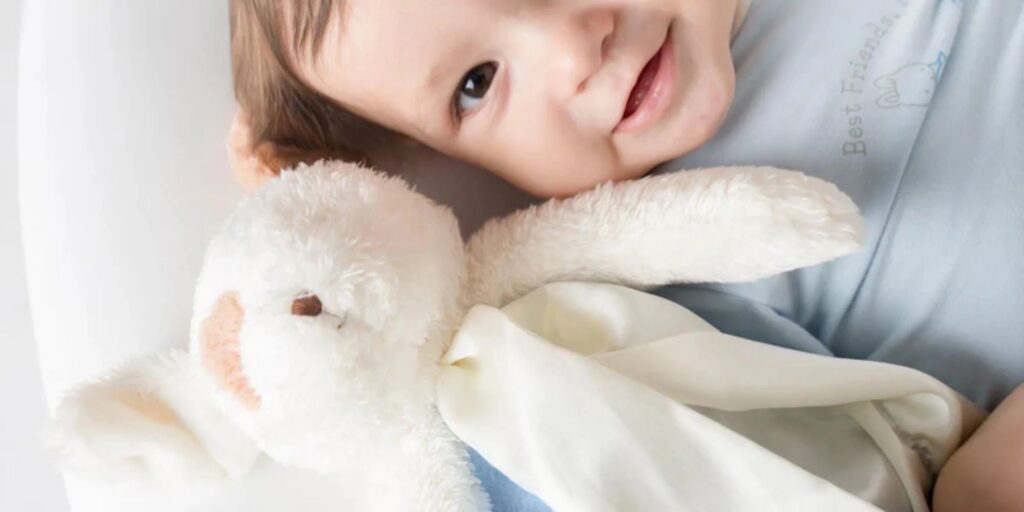
Regular light cleaning every 1–3 months, with deeper cleaning or deodorizing every 6–12 months, keeps plush toys hygienic and fresh.
Dust and surface clean every 1–3 months; deodorize or deep clean twice yearly for optimal hygiene.
- Daily Maintenance: Avoid eating or drinking near plush toys to minimize stains.
- Seasonal Cleaning: Align deeper cleaning with seasonal changes or allergy seasons.
- Monitor for Damage: Frequent checks prevent buildup that can cause fabric deterioration.
- Health Considerations: For children with allergies, clean more frequently to reduce dust mites.
- Storage Tips: Store toys in breathable containers when not in use to minimize dirt accumulation.
- Adjust Frequency: More frequent cleaning needed for heavily used toys or in dusty environments.
Proper cleaning intervals balance hygiene with preservation of toy quality.
| Cleaning Frequency | Beschreibung | Tips / Notes |
|---|---|---|
| Light Cleaning | Every 1–3 months, dust and surface clean | Keeps toys hygienic and fresh |
| Deep Cleaning / Deodorizing | Every 6–12 months | Removes odors and deeply embedded dirt |
| Daily Maintenance | Avoid eating/drinking near toys | Minimizes stains and dirt buildup |
| Seasonal Cleaning | Align with seasons or allergy periods | Helps reduce allergens and refresh toys |
| Damage Monitoring | Frequent checks | Prevents fabric deterioration |
| Health Considerations | More frequent cleaning for allergy-prone children | Reduces dust mites and allergens |
| Tipps zur Lagerung | Store in breathable containers when not in use | Minimizes dirt accumulation |
| Adjust Frequency | Increase cleaning in dusty or heavily used environments | Maintains hygiene and appearance |
Cleaning Methods vs. Toy Materials
| Reinigungsmethode | Suitable For | Not Recommended For | Anmerkungen |
|---|---|---|---|
| Soft Brushing | All plush toys | Keine | Gentle, non-invasive |
| Vacuuming (low suction) | Most fabric types | Delicate mohair, vintage | Use mesh screen to protect fibers |
| Baking Soda Deodorizing | All plush toys | Avoid excessive use on delicate | Effective for odors |
| Spot Cleaning (microfiber) | Durable fabrics | Water-sensitive materials | Use minimal moisture |
| Dry-Cleaning Powders | Non-washable, collectible toys | Toys with glued parts | Follow product instructions |
| Professional Cleaning Services | Valuable, vintage plush | Keine | Best for fragile or valuable toys |
| Dampfreinigung | Synthetic plush | Delicate fibers, electronics | Use low heat, test small area |
Ready to Keep Your Plush Toys Clean and Safe?
Cleaning plush toys that cannot be washed demands care, the right methods, and sometimes professional help. At Kinwin Plush Factory, we specialize in designing and producing high-quality, durable plush toys with materials that balance softness and ease of maintenance. If you want custom plush toys designed for durability and easy cleaning, or need expert advice on care, don’t hesitate to contact Kinwin for personalized solutions. Let us help you bring safe, beautiful, and lasting plush companions to your customers.




